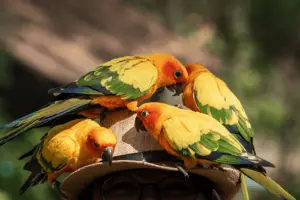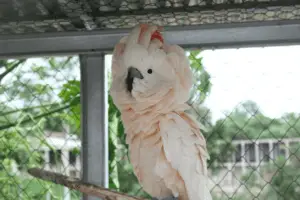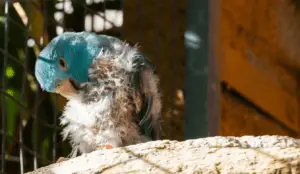With a bright personality and an even brighter plumage, conures are a favorite among bird lovers. And thanks to their attention-seeking behaviors and spunky attitudes, they’re clowns in the bird world. But do you know the planet has over 12 types of conures? For more on these birds, please read on.
Key Items
- Sun conures are noisy in a flock, but when separated from their flock, they can become noisier and start making high-pitched noises. The only time they’re silent is when feeding.
- In Brazil, authorities forbid the exportation of Jandaya parakeets, but poachers continue to export them to other nations.
- Besides their usual diet, the white-eyed conure gets minerals from clay licks. The clay also helps them eliminate the toxins in their bodies.
- According to the World Parrot Trust, Keeping Nanday parrots in an aviary about 3 meters long is necessary because they require more than enough space to burn the extra energy.
- The Green-cheeked conures have the shortest lifespan of the entire world’s conures. Plus, they’re considered one of the quietest parrots available.
- The golden parakeet can develop a vocabulary; they can be pretty vocal and loud.
- The Patagonian conure is a unique parrot that can’t be easily mistaken for another species.
- In Argentina and Chile, the Patagonian conures are known as “little clowns” thanks to their playful and charming nature. On top of that, they don’t fear strangers.
- The Dusky-headed conures make great pets mainly because they’re less demanding out of all conures.
Conures make exceptional pets; in fact, some of them are very easy to train. So before you adopt any parakeet, you should find out if it matches your personality. We have compiled the following guide on different conures to help you get a parrot matching your personality.
12 Types of Conures
- Sun Conure
The sun conure is a perfect definition of a beautiful parrot; therefore, if you love brightly colored parrots, then this bird is for you. The sun conure or sun parakeet is indigenous to northeastern South America. They’re social creatures that live in flocks of up to 30 individuals in the wild. So you can find them in monogamous reproduction pairs nesting in some palm cavities.
According to Wikipedia, Sun parakeets are loud parrots that produce high-pitched screams with other conures. In terms of appearance, the males and females have similar features; some of the similarities include:
- Blue and green-tipped tails and wings.
- Orange-flushed face and underface
- Golden-yellow plumage
- Black beaks.
But the hens have slender and lighter bodies with smaller beaks, rounder heads, and shorter tails. The adults come with a beautiful yellowish mantle, nape, crown, underwing coverts, and chest.
Being social creatures, they rarely leave their flocks; when separated from their flock, they can scream and squeal in high-pitched voices.
Fortunately, they can be noisy when flying around but quiet when feeding. And being fast flyers, they can cover miles in a single day. The sun conures in the same flock are known for preening, bathing, and feeding each other.
Adopting one is a huge commitment because one can live for over 30 years in captivity. So before adopting one, you should be ready to commit to raising one and spend more than enough time with them. The Suns consume social creatures, so you must be prepared to keep it busy and play around. Their diet includes nuts, seeds, insects, blossoms, berries, fruits, and flowers.
- Jenday Conure
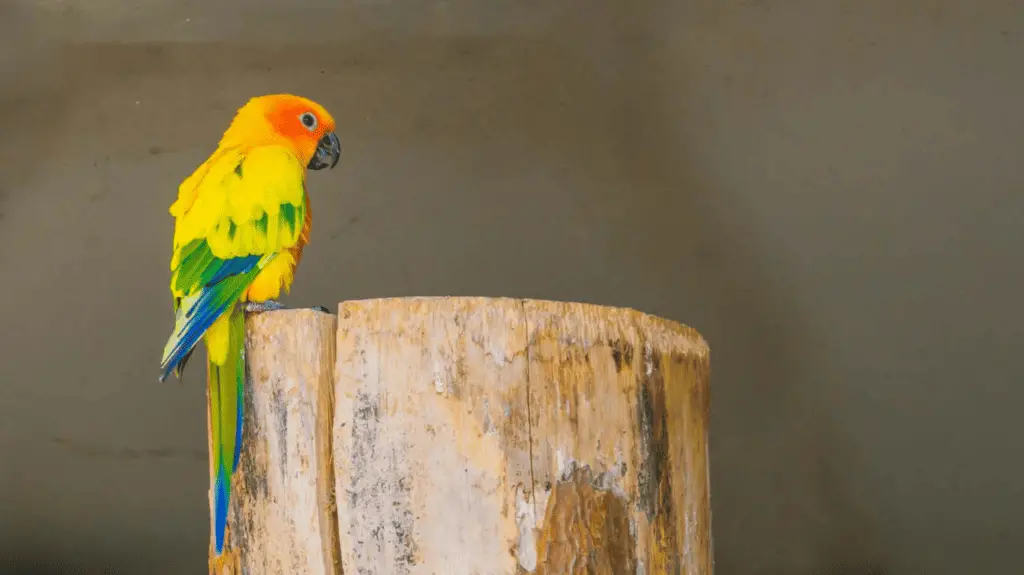
If you love sun conure, you will adore Jenday or Jendaya parakeet. They are native to the palm groves and the lowland woodlands of Northeastern Brazil, mainly in Ceara, Tocantins, Maranhao, and Piaul.
Jenday consumes cashew apples, palm nuts, and mangos. Jandaya Parakeet is closely related to sun conure and can be its subspecies. Jandaya has a wide range of habitats, but it’s rare locally in the wild. They’re pretty standard in aviculture and can make exceptional pets.
According to Wikipedia: unlike the Sun conures, the Jandaya conures are small, long-tailed parrots with the following:
- Green wings, tails, and vent
- Reddish-orange bodies
- Yellow shoulders, neck, and head
- Orange cheeks
- Dark eyes
- Black bill
Jandaya makes hosts in tree hollows about 50 feet off the ground. But in captivity, they tend to lay up to 6 eggs and then incubate for 26 days.
After hatching, the parents feed for about two months. Like the Sun Conure, Jandaya parakeets can live up to 30 years. IUCN has listed them as low on the endangered list.
Jandayas, with their intelligence, make excellent pets that anyone can train to do anything. These small-sized birds can easily mimic sounds like phrases and words. They’re social creatures that stay in flocks.
Therefore, they love calling each other frequently and very loudly. They love cuddling and can quickly bond with their human family members. Jandayas are birds that demand attention and love spending time outside.
- White-Eyed Conure
The white-eyed conures are exceptional parrots that make great pets of all conures. And that’s because they’re docile; after all, they’re the best-behaved parrots on the planet. Plus, if you socialize with it regularly and take care of it, you should expect your pet to make an exceptional pal and companion. Plus, it’s both affectionate and entertaining. Unlike most parrots, the white-eye conures are less mischievous and quieter parrots.
They’re small bright greenish parrots found in South America. They live in the woodlands, mangroves, and forests in the wild, but humans can also find them in urban regions. They weigh about 7.7 oz., with the sexes looking alike.
Adult white-eyed conure is:
- Green, but paler on the underparts.
- The underside of their tail and flight feathers are olive.
- They have orange eyes surrounded by yellowish, white, to whitish skin.
- They come with reddish dots on the neck and head.
On the other hand, the white-eyed conure chicks resemble adults in color but don’t have red dots on their wings and heads.
In the wild, they’re known for congregating in flocks whose numbers may exceed seven hundred and may even include other parrot species.
This parrot species roost in trees and live in caves and the cane field. Their diet consists mainly of fruits, flowers, seeds, and arthropods. It’s also known for visiting the clay licks.
- Nanday Conure

Native to the pastures and open savannas in central South America, the Nanday parakeets are medium-sized birds that make great pets. Unfortunately, they’re not known to be quiet as most parakeets. Due to caged parrots escaping, there is a small population of self-sustaining birds in Florida and California. These medium-small sized creatures are usually green and weigh about 4.9oz.
One of its other distinguishing features is its black beak and facial mask that gives it its other name, the black-hooded conures. Some of its other unique features include:
- Bluish-green upper chest
- Paler green lower chest
- The feathers covering their thighs are red
- Blackish trailing flight feathers along its wings
- The feathers on its tail are blue
Despite being loud, these birds are energetic and demand much social and mental stimulation. So they will have to spend some time outside the cage to thrive. They’re not the best option for a house of small children since they have very powerful beaks.
In captivity, they can learn to talk and easily do several tricks. The World Parrot Trust claims that we should keep this bird between 2 and 3 meters long in an aviary. And if well-taken care of, they can live for an average of 18.7 years.
But some have been known to exceed 30 years. So these birds can guarantee an excellent company for up to 3 decades. Therefore, you must be ready to care for your pet, particularly the Nanday conure.
Remember, they can become very noisy if you don’t provide them with the required stimulation and attention. They can even start displaying some destructive behaviors.
- Green-Cheeked Conure
Native to South and Central America, this species forms a huge flock in the trees in their natural habitats. They live primarily in Paraguay, Brazil, Bolivia, and Argentina. These parrots are closely related to the Crimson-bellied, pearly, and maroon-bellied parakeets. In the wild, they breed in high elevations and move to the lower regions in winter.
Like most parrots, the males and females look similar; they weigh between 2.2 and 2.9 oz. These birds have the following features:
- They have green cheeks.
- They have ashy brown ears.
- They come with a dull brown color from the nape to their foreheads.
- Their wings are green, while the flight feathers are bluish.
- They come with dull reddish tails; the main difference between juveniles and adults is that the immature ones don’t have red bellies.
The green-cheeked conures have a special diet that includes flowers, seeds, leaves, nectar, and fruit in the wild. Fortunately, they make exceptional pets and are considered one of the quietest species available, but they can be active and require lots of exercise.
They’re funny and curious creatures that love forming bonds and enjoy attention from their owners. They can be taught a limited number of vocabularies and can learn a few tricks in progress.
Therefore, if you’re not keen on a loud parrot or live in an apartment, you should go for the green-cheeked conure. Keep in mind; these birds have the shortest lifespan of all conures.
- Peach-Fronted Conure
Commonly found in the South American savannas, the perch-fronted parrots spend a considerable percentage of their day foraging for insects, leaves, flowers, and seeds. These birds live in Suriname, Peru, Paraguay, Brazil, Bolivia, and Argentina.
They inhabit many landscapes, from wooded to semi-open land, including palm groves, urban regions, campo rupestre, and cerrado.
The male and female parakeets are similar and weigh between 2.6 and 3.3 oz. Some of their unique features include:
- Adults come with peachy orange forecrowns and foreheads.
- Their posterior crowns are dull blue.
- They have yellowish skin surrounding their eyes
- Their tail, upperparts, and nape are dull green
- Their throat and breast are olive-brown, transitioning through their belly and breast to a greenish-yellow vent.
- Their wings have a yellow-green bottom and are primarily greenish on the top.
Despite the similarities between the males and females, the immature birds are quite different. For instance, the young ones have blue and less orange on their heads. These birds are closely related to the green-cheeked parakeets; therefore, they share several similarities.
But they differ significantly from their cousins and are always considered gentler than human beings. The green-fronted conures are sweet, playful creatures, especially around their owners, and can become aggressive with other pets and birds.
These birds come with a cheerful personality and love chewing everything around them. They are cuddly, quiet, and loving, making them the best option for people living in apartments.
- Golden Conure

Also referred to as the Queen of Bavaria, the Golden Conures are medium-sized birds native to the Amazon region, particularly in Northern Brazil. Golden conures are considered the most expensive birds in the pet industry.
It’s the only conure species belonging to the Guaruba genus. They come with bright yellow plumage with greenish remiges.
The golden parakeet resides in the drier upland parts of the rainforests in the Amazon Basin. You can find them in open land at the edge of the forests during the breeding season. Flooding and deforestation threaten its population. Currently, it’s illegal to trap this species in the wild for pet trading.
These parrots are about 14 inches long and are primarily yellowish with green color on their outer wings and yellow tail. It has brown irises, pale pink eye rings, gray beaks, and pink legs. Generally, both sexes have similar features.
On the other hand, the juveniles are dull and greener plumages and are lighter than the adults. The neck and head of the youngsters are primarily green. Their backs are yellow and green, while their breasts are green. Their legs are brown and have pale-gray eye rings.
They’re social creatures that live, feed, and even breed together. They consume acai, mango, many seeds, buds, and flowers.
These parrots make excellent pets; if you purchase one, you will be lucky enough to live with an intelligent and active pet. The golden parakeet can develop a vocabulary; they can be pretty vocal and loud.
- Patagonian Conure

Another unique parrot that can’t be easily mistaken for another species on the planet is the Patagonian conure. Also known as the burrowing conure, this species has white eye rings, olive green bodies, whitish breast markings, and brightly colored underparts.
These birds may seem similar in our eyes, but they’re sexually dichromatic. The males tend to have a larger and redder red patch on their abdomen. When looking under UV light, the females have bright blue feathers, while the males have bright green feathers.
They get their name from their burrowing behavior. These birds are known for creating elaborate burrows in the ravines and cliff faces for rearing their chicks. These birds are native to Argentina, but Chile has an isolated population.
But in winter, they migrate to southern and central Argentina, while others go as far as Uruguay. These birds prefer an open and dry country and will likely be near a watercourse where they feed on fruits, berries, seeds, and vegetables.
In Chile and Argentina, the locals refer to these birds as “little clowns” thanks to their charming and playful nature. They are outgoing birds that love dancing, mimicking our speech, and playing with toys, proving they make great pets.
However, they need much attention, especially if you don’t want them to become mischievous. Another unique thing about them is that they don’t fear strangers, so they can quickly become the life of any party.
- Red-Masked Conures
Thanks to its red face and green feathers, this parrot is easy to spot in its natural habitat in the jungles of Ecuador and Peru. They’re small-sized creatures referred to as Cherry-headed conures in aviculture. They’re the best talkers among conures, which is one of the key reasons it’s popular in the pet trade. The locals love this parrot and keep it for its comical personality.
They’re bright green birds with red heads and some conspicuous pale eye-rings. Their nape is also green. On top of that, they have some red on their:
- Thighs
- Neck
- Underwing
- The leading edge of their wings
Their young ones have green plumage, and their first red feather appears at four months. In the wild, they live in northwestern Peru and Southwestern Ecuador, where they reside in deciduous forests and jungles.
They can also thrive in suburban and semi-arid regions, where they eat flowers and fruits while nesting in palm trees.
The red-masked conures make great pets; in fact, they’re very easy to train; plus, being talkative is a bonus. But they can be very loud and love being the center of attention.
So when bringing one home, you should be ready for the noises.
- Dusky-Headed Parakeets
Also referred to as Weddell’s conure, the dusky-headed bonuses come with gray heads and live in the wooded parts of the Amazon basin. This parrot is native to Bolivia, Brazil, Peru, Ecuador, and Colombia.
In their natural habitat, you can find them in semi-open habitats like forest remnants and forest edges, but they do love exploring coffee plantations. It’s a common creature whose habitat choice protects it from predators.
These long-tailed creatures are usually green, but you can also find some blue and lutino mutations. Their other unique features include:
- Broad and bare white eye-rings
- Black bills
- Gray-brown heads
- Blue-tipped tail
They weigh around 100 grams, and they’re considered a bit bigger than Sun conures. Some folks call them mini macaws, thanks to the skin near their eyes and beaks.
In the wild, they live in small groups or pairs. And when food is plenty, you can find them in groups of over 100 individuals. They consume flowers, seeds, and fruit; they’re known for exploring decaying woods for insect larvae.
On top of that, these birds consume clay-lick, mineral-rich soil as a supplement. The clay neutralizes the toxin in their food while giving them the needed minerals.
In captivity, these birds do well; they’re straightforward to breed, primarily when provided with a reliable nest box. They’re known for laying about three clutches of eggs every year.
And compared to other conures, this parrot is pretty quiet. But you should be ready to take care of your bird since they’re very energetic but clownish, just like most parakeets. Remember, they can live for up to 5 decades, so if you’re looking for a lifetime companion, you should try the dusky-headed parakeet.
Even without the bright-colored feathers, they’re stunning birds. But one of the top reasons they make great pets is that they are less demanding. These parrots are naturally loving and ideal for children.
- Blue-Crowned Conure
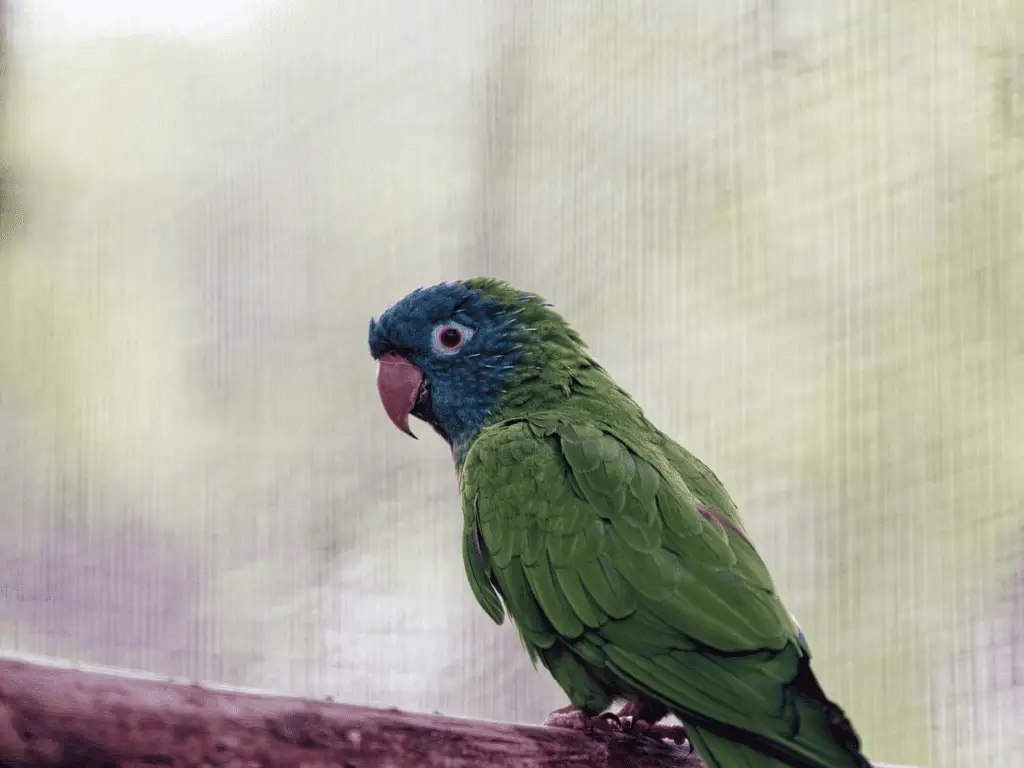
Blue-crowned parakeets are a small group of greenish neotropical birds with pale beaks and blue heads. These birds are indigenous to a considerable part of South America ranging from Argentina to eastern Columbia.
They inhabit some savanna-like environments, woodlands, and forest margins; unfortunately, they do avoid places with dense humid forests. This parrot is a medium-sized creature weighing between 4.9 and 6.7 oz. Some of its distinctive features include:
- They’re born with some red feathers around their head
- They are predominantly green
- They have dull blue ears, cheeks, crowns, and foreheads.
- They have a white featherless ring surrounding their eyes, but these rings can be orange-yellow in the wild.
- The birds’ breast feathers fringe with blue, but they range in color from yellow to green
- The underside of their tail feathers is yellow, while the upper part is green.
These birds nest in holes in trees, laying 3 to 4 white eggs per clutch. The Blue-crowned parakeets are sweet and intelligent creatures; therefore, you can easily teach your pet some words and tricks they can easily understand.
- Mitered Conure
Until 2013, scientists classified the Mitred conure under the Aratinga genus, despite its native range in Peru, Bolivia, and Argentina. Then, they presented the Psittacara genus as a new classification for this species.
These parrots weigh between 7.7 and 9.7 oz and are about 16 inches long. Just like most parrots, the males and females look alike. The adults are green with purple foreheads. They also have a variable of red patterns on their face.
The red extends to their cheeks and past their eyes, plus some flecks on their ears. The mitered parrots have several subspecies, with P. M. Chlorogenys having less-reddish feathers below the eyes. Some white skin surrounds their eyes, while their bills are horn-colored. This bird’s diet in the wild is composed of berries and fruits, nuts, seeds, and maize.
They’re curious, comical, playful, and high-spirited creatures that make great pets. But they can be pretty temperamental birds in need of your attention. And without your attention, they can turn to nipping and screaming.
The Mitred parakeets are not ideal for beginners, but they can make exceptional pets for folks with time and ready to make an effort to socialize and train.
Conclusion
If you love conures, you must be confused about which species to pick; they all have unique characteristics. For instance, some parakeets can live for over five decades, so you should be ready for long-term companionship.
It means caring for your pet daily for as long as you live. So if you’re looking for a lifelong pal, avoid the Green-cheeked conures.
Fortunately, they’re intelligent creatures, so you can train them and ensure they adapt to your surroundings. On the other hand, Golden parakeets are vocal creatures that can quickly learn a few words. But if you want a unique bird, try the Patagonian conure.
The Burrowing parakeet is a unique pet that stands out thanks to its special features. So before adopting a conure, you should be ready to handle a demanding pet that makes exceptional pets.
- Wikipedia contributor, Sun Parakeet, https://en.wikipedia.org/wiki/Sun_parakeet/ Accessed April 27, 2023
- Wikipedia contributor, Jandaya Parakeet, https://en.wikipedia.org/wiki/Jandaya_parakeet#Description/ Accessed April 27, 2023
- Wikipedia contributor, White-eyed parakeet, https://en.wikipedia.org/wiki/White-eyed_parakeet#Description/ Accessed April 27, 2023
- Wikipedia contributor, Nanday parakeet, https://en.wikipedia.org/wiki/Nanday_parakeet/ Accessed April 27, 2023
- Wikipedia contributor, Green-cheeked Parakeet, https://en.wikipedia.org/wiki/Green-cheeked_parakeet/ Accessed April 27, 2023
- Wikipedia contributor, Peach-fronted parakeet, https://en.wikipedia.org/wiki/Peach-fronted_parakeet/ Accessed April 27, 2023
- Wikipedia contributor, Golden Parakeet, https://en.wikipedia.org/wiki/Golden_parakeet/ Accessed April 27, 2023
- Wikipedia contributor, Burrowing parrot, https://en.wikipedia.org/wiki/Burrowing_parrot#Diet/ Accessed April 28, 2023
- Wikipedia contributor, Red-masked Parakeet, https://en.wikipedia.org/wiki/Red-masked_parakeet/ Accessed April 28, 2023
- Wikipedia contributor, Dusky-headed Parakeet, https://en.wikipedia.org/wiki/Dusky-headed_parakeet/ Accessed April 28, 2023
- Wikipedia contributor, Blue-crowned Parakeet, https://en.wikipedia.org/wiki/Blue-crowned_parakeet#Description/ Accessed April 28, 2023
- Wikipedia contributor, Mitred Parakeet, https://en.wikipedia.org/wiki/Mitred_parakeet/ Accessed April 28, 2023





